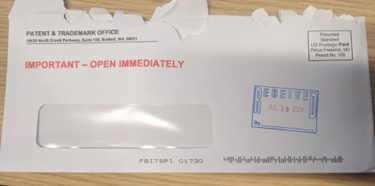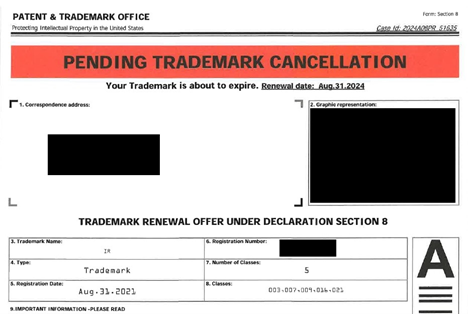In a guest article, Venable's Rebecca Liebowitz, Andrew D. Price, and Samantha J. Moskowitz examine the rise in increasingly sophisticated trademark fraud and what practitioners can do to minimize the risks for clients.
Venable has seen an increase in trademark scams being sent to clients over the last several years. This is not surprising, considering the increase in trademark filings, new e-commerce, and small businesses since the start of the pandemic.
Examples of recent scams
There are two prominent types of scams we see most frequently.
The first is the type of scam we have been seeing for decades, where a trademark owner receives an invoice or notice from some kind of "'trademark service'" that their application or registration needs some kind of filing to maintain their status and prompts them to pay an outrageous sum to receive these "'services'," which are unnecessary or made up (see example below).
They usually reference some false impending deadline and aim to feed on a trademark owner's anxiety that they will lose their registration if they do not comply.

The second type of scam we are seeing more recently is "'attorneys'" emailing clients about urgent deadlines regarding proposed new third-party filings. Alternatively, they will allege third-party applications that present a threat to the client's brand, often claiming that another party with the same or similar mark is using them to file an application, but they would like to give the client the chance to file first (see example below).

In an ideal situation, clients will forward these to us to confirm they are scams before engaging with these bad actors.
Historically, these trademark email scams have generally been easy to spot. The emails usually:
- have poor grammar
- reference nonexistent laws and
- threaten financial damage if the client does not comply with the scam demands
The scams become harder to detect when the emails and letters pose as official notices from the USPTO, and clients assume these are legitimate, as they use the official USPTO logo or identify themselves using a name such as "'Patent & Trademark Office'." On top of that, they often use actual serial/registration numbers for the trademarks (see examples below).


These kinds of scams usually demand phony and outrageous government filing fees for "renewing" registrations that far exceed the actual fees the USPTO charges.

It is likely that the rise in these scams is due to the increased ease with which scammers can access publicly available information about applicants' and registrants' marks and business information. With easy access to this information from the USPTO website and the increasing accuracy of AI language-generation tools, scammers can tailor their emails to sound more legitimate and scare applicants into paying fake invoices or engaging fraudulent trademark services.
USPTO response and what can be done
To date, the USPTO has devoted several web pages to helping stakeholders determine what is legitimate and what is fraudulent. These pages include educational materials about identifying scams and how to avoid them, and provide examples of fraudulent emails, letters, certificates of registration, and invoices.
The USPTO also provides information about what to do if you receive a scam email and how to report the fraud, along with a running list of known scams and fraudulent entities for applicants/registrants to use in identifying scams before falling victim to them. There is also an email address on the USPTO website for reporting fraud.
All that being said, at least one client has reported to us that the USPTO does not typically respond after receiving such complaints; therefore, if you are a trademark owner and are in doubt about the veracity of a mailing, check with your trusted trademark counsel.
One tactic the USPTO could rely on to go after bad actors that might yield more favorable results is its trademark registrations. In 2022, the USPTO obtained registrations for four marks related to its name and logo, all in the name of "United States Patent and Trademark Office, U.S. Department of Commerce":
- UNITED STATES PATENT AND TRADEMARK OFFICE (Registration No. 6,832,042)
- USPTO (Registration No. 6,832,019)
 (Registration No. 6,832,047)
(Registration No. 6,832,047) (Registration No. 6,832,052)
(Registration No. 6,832,052)
The USPTO could consider using these registrations to better protect the public against fraudulent activity, particularly against bad actors that pose as the USPTO to trick stakeholders. While the USPTO does not currently have legal authority to sue scammers, it could
- Work with the Department of Commerce and/or other agencies in the short term to do so (within the constraints of agency authority)
- Take more aggressive steps to raise public awareness itself and
- Lobby to gain its own authority to sue bad actors in the future
Moreover, the USPTO could start issuing sanctions against these bad actors and prevent them from making filings with the USPTO.
These increasingly brazen scams call for equally aggressive action by the USPTO. It is time for the USPTO to attack this problem with the same vigor it has used to combat fraudsters from China; this is just a U.S.-based version of bad actors gaming the system.
How practitioners can help clients
As technology, AI, and e-commerce business continues to advance, so will the sophistication of trademark scams. In the meantime, we as practitioners can help clients to defend themselves against these scams through the following steps:
- Educate clients and provide regular updates about emerging scam and fraud tactics to help them stay alert and informed. We can advise clients on how to recognize the red flags in suspicious documents and emphasize that they should forward to us any communication that they are unsure about to determine whether it is legitimate or fraudulent
- Share the USPTO resources with clients to reinforce the importance of verifying all trademark-related communications, including, in particular, invoices
- If a client does fall victim to a scam, help them to take legal action, including by reporting the fraud to:
- the USPTO
- the Federal Trade Commission
- the Federal Communications Commission and/or
- the FBI (depending on the type of scam)
Unfortunately, these are not the only scams being committed. We have seen people attempt to change correspondence information on trademark registrations (which the USPTO has blocked) and even list fake attorney names and bar information on filings.
Ultimately, the best way to safeguard the integrity of the U.S. trademark register is for all of us to work together, with increased vigilance by trademark owners, the USPTO, and the Trademark Bar.